The all-electric Sun Flyer 2 prototype two-seater being developed by Bye Aerospace made its first flight at Centennial Airport, Denver, Colorado, earlier this week.
Sun Flyer 2 is aimed at flying schools around the world as a low-operating cost, low noise, environmentally-sound training aircraft. George Bye, founder and CEO of Bye Aerospace, is claiming Sun Flyer 2 will burn $3-worth of electricity per hour and have total operating costs of just $14.00/hour.
“We are excited about the future and the potential the Sun Flyer family of aircraft has to revolutionize general aviation, providing improved affordability and accessibility,” said Bye after the first flight.
“Lower operating costs are key to solving the student pilot drop-out rate, which is curtailing the successful attainment of badly needed airline pilots.
“The Sun Flyer 2’s $3 hourly operating costs are 10 times lower than traditional piston-engine flight trainers, with no carbon emissions and significantly reduced noise.”

Bye Aerospace is claiming energy costs of just $3/hr for Sun Flyer 2, with total operating costs of $14/hr.
EP Systems provided the energy storage system for the Sun Flyer 2 prototype aircraft, including battery modules (packs), battery management unit and power distribution unit.
The battery cells are LG Chem MJ1 lithium-ion battery cells with a 260Wh/kg energy density. Bye Aerospace will soon announce who its electric motor partner will be for the family of FAA-certified Sun Flyer aircraft.
The Sun Flyer, which is to be FAR 23 certified, is powered by an electric propulsion system. Six lithium ion batteries run the electric propulsion system, which directly drives the composite propeller.
Engine performance is controlled by an electronic control unit which ensures optimal use of the energy stored in the batteries. The electric design features reduced cooling drag compared to a conventionally powered aircraft and nose frontal area is reduced due to a smaller motor size and cooling intake required.
The aircraft’s cockpit employs an iPad used for cockpit instrumentation display including motor, battery and aircraft systems. It connects to Redbird Flight Simulation’s Sidekick system, which wirelessly tracks the Sun Flyer’s engine, flight time, physical location and altitude in real-time when in flight.
Bye Aerospace says it has 105 deposits for Sun Flyer 2 production aircraft. The company is also working on a four-seat Sun Flyer 4 with operating costs of $19.80/hr.
Sun Flyer













